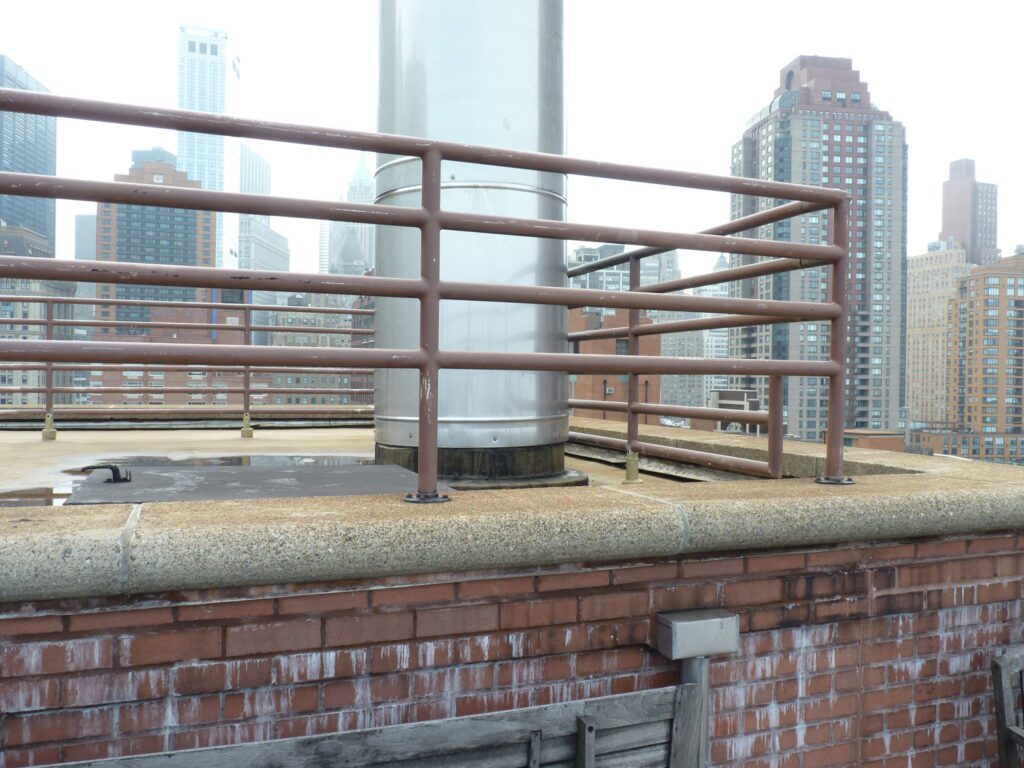FISP Guardrail & Railing Regulations
October 19, 2020

At HLZAE, we are fully prepared to handle all of your FISP needs including Guardrails and Railings. Below, we have outlined the current DOB requirements for these parts of your building:
Building Code Requirements
New York City Building Code requires that railings and parapets around stairwells, balconies, areaways, roofs, and similar locations shall be designed to resist the simultaneous application of a lateral force of fifty (50) pounds per linear foot (plf) and a vertical load of fifty (50) plf, both applied to the top of the railing.
FISP Requirements
All railings, handrails and guardrails must be investigated for structural safety and code compliance. Structural safety will be determined by lateral load stability, overall condition of the material, condition of connections and anchorage points. Dependent upon on the condition of the railings at the time of inspection, invasive structural testing may be required to confirm the structural stability and load capacity of the railings.
The railings must also be inspected for code compliance. This will determine if the railings were appropriate to the code at the time they were installed. Code compliance will not dictate whether railings are Unsafe unless it results in a danger to public safety. If handrails and guardrails did not conform to the applicable codes when installed, the QEWI shall notify the Owner and these items will be noted in the report. In these circumstances, the DOB requires that a course of action be implemented to bring all non-code compliant items up to code by the closure of the next FISP Cycle.
If observations reveal Unsafe conditions, all balconies, terraces, and/or exterior common areas must be VACATED until conditions are corrected and made safe.
On September 6th, 2013, the DOB issued an amendment Memo to rule RCNY §103-04, which specifically requests that balcony railings and connections be checked for structural soundness. Depending on the condition of the inspected railings, the QEWI may determine that ALL balcony railings should be checked, instead of a representative sample. Defective railings or connections may govern the status of the façade.
Visual Inspection of Balconies and Guardrail Systems
At the discretion of the QEWI, a representative sample of the total railings may be sufficient in determining the condition of the railings; however, HLZA strongly encourages full inspection so Owners can be confident their residents’ safety is assured as it is good practice and part of a recommended maintenance program for every building.
Each balcony should be inspected systematically to ensure a consistent procedure and thorough assessment. During these inspections, each railing will be visually inspected for broken or missing components, observed laxity at component connections, and any damaged or missing mechanical connection to the balcony slab and building façade. During the course of the critical examination, photographs shall be taken and/or sketches made to properly document the location of all conditions observed that are either unsafe or SWARMP.
Fire Escapes
Fire escapes must be investigated for structural safety. Structural safety will be determined by the condition of the anchorage points, overall condition of the steel, condition of the connections and of the treads. Per the building code, fire escapes must be maintained by the building owner at all times for public and occupant safety.
Balcony Enclosures
The QEWI will inspect balcony enclosures at the property. Enclosures will be classified as either safe or unsafe depending on stability of installation. If they are in danger of failure or are structurally unstable, it will be noted as an Unsafe item.
Balcony enclosures require a permit for installation. Balcony enclosures that have been used to create habitable space shall be counted against F.A.R. (Floor Area Ratio) when applying for a permit. Enclosed balconies should not have heating/cooling elements. Enclosures that make up 67% or more of the balcony perimeter also count toward F.A.R.
Additional Safety Measures
In addition to FISP inspections, there are several other measures that can be taken in order to guarantee the safety of a building’s guardrail systems:
- Contract an engineering entity to perform uniform and/or concentrated load tests on select areas of the guardrail system in order to determine whether or not it conforms to the current New York City building code.
- Implement an annual routine maintenance plan in order to address potentially dangerous conditions more promptly than is required by the FISP program.
- Inform tenants to pay attention to the condition of all guardrails on their respective balconies, and to promptly report any outwardly unsafe conditions to the building superintendent for immediate repair.
Recommended Articles
Sorry, we couldn't find any posts. Please try a different search.